Do you ever wonder how shoppers find your products even when they don’t use the exact words from your product title? That’s the power of Amazon backend keywords.
These hidden keywords help Amazon’s algorithm connect your product with relevant customer searches. While they don’t appear on your listing, they play a crucial role in improving your ranking and visibility.
Knowing how to find and optimize backend keywords can drive more traffic to your listings and boost sales. In this guide, you’ll learn everything you need to know about Amazon backend keywords; how to find them, add them to your listings, and check if they’re working.
Table of Contents
Amazon Keywords: The Foundation of Discoverability
Amazon keywords are the search terms that connect your products with potential buyers. These are the words and phrases shoppers type into Amazon’s search bar when looking for something to purchase.
When a shopper enters a keyword, Amazon’s algorithm scans product listings to find the best matches. It considers titles, bullet points, descriptions, and backend keywords to determine which products are most relevant.
For example, if you sell a stainless steel water bottle, relevant keywords could include “insulated water bottle”, “metal water bottle”, or “water flask”. Using these variations increases your chances of appearing in search results.
A strong keyword strategy is essential for boosting visibility, attracting more traffic, and ultimately increasing sales. The better your keywords align with customer searches, the more likely they are to find and buy your product.
Different Types of Amazon Keywords
There are different types of keywords sellers can use in their product listings. Each type serves a unique purpose in improving product visibility and sales.
- Primary Keywords: Main terms that describe your product, placed in titles and key listing sections.
- Long-Tail Keywords: Specific phrases with lower competition but higher conversion potential.
- Competitor Keywords: Terms competitors use that can reveal new keyword opportunities.
- Seasonal Keywords: Keywords relevant to holidays, events, or seasonal trends.
- Brand Keywords: Your brand name and its variations to attract brand-loyal customers.
- Backend Keywords: Hidden terms that help Amazon index your product without appearing on your listing.
What are Amazon Backend Keywords?
Amazon backend keywords, also called hidden search terms, help improve product discoverability without appearing in your Amazon listing. These keywords are indexed by Amazon’s algorithm, allowing sellers to target additional search terms beyond what’s visible on the product page.
Amazon Backend Keywords Guidelines
No matter how many backend keywords you add, they won’t be effective if you don’t follow Amazon’s guidelines. Ignoring these rules can lead to wasted space, missed indexing opportunities, or even policy violations.
Amazon allows up to 250 bytes for backend keywords, not characters, meaning special characters and accented letters take up more space. To maximize this limit, use only essential, unique keywords without unnecessary repetitions, ensuring every byte contributes to search visibility.
However, simply filling up the backend keyword space isn’t enough, Amazon also enforces strict rules on what can be included. Prohibited keywords, such as offensive language, misleading claims, and promotional terms, are not allowed and can lead to suppression or policy violations.
Importance of Amazon Backend Keywords
There are many reasons sellers use backend keywords, but these are the most important ones:
- Helps Amazon’s algorithm rank your product for more keywords
- Keeps titles and descriptions clean while still optimizing for search.
- Allows keywords like “best gifts for singers” that wouldn’t fit naturally in a listing.
- Gets you to rank for overlooked keywords that competitors might miss.
- Hidden keywords prevent competitors from easily copying your optimization tactics.
Find the Best Backend Keywords for Your Amazon Products
Now that you understand the importance of backend keywords, you might be wondering how to find the best ones for your products. Below are some effective methods:
Use Amazon Autocomplete
Amazon’s search bar is a goldmine for finding relevant keywords. Start typing a keyword related to your product, and Amazon will generate a list of suggestions based on real customer searches. These suggested terms are high-traffic keywords that customers frequently use.

Analyze Your Amazon PPC Search Term Reports
If you run Amazon PPC ads, your Search Term Report provides valuable data on which keywords customers use to find and purchase your product. These are real-time insights into effective keywords.
Look at Competitor Listings
Your competitors’ listings can reveal valuable keywords that are already driving sales. By studying their product titles, bullet points, and descriptions, you can identify keywords they are optimizing for.
Check Amazon’s "Customers Also Bought" Section
This section on Amazon product pages shows products frequently purchased together. It helps you discover related keywords and alternative terms customers use when shopping for similar products.
Keyword Research Tools
Amazon keyword tools like Helium 10 and Jungle Scout provide detailed keyword data, including search volume, competition, and trends. These tools help you find profitable backend keywords that might not be obvious through manual research.
Amazon Backend Keywords Dos and Don’ts
We have established that backend keywords can improve your product’s visibility, but this is only true if you use them correctly. If you’re not strategic, you could be wasting valuable space or, worse, hurting your ranking.
To make the most out of them, here’s what to do and what to avoid when optimizing your backend keywords on Amazon.
Dos in Using Backend Keywords on Amazon
1. Conduct Thorough Research
Use keyword tools, competitor analysis, and search term reports to find high-ranking and popular keywords. Strong research ensures you target terms that customers actually search for.
2. Maximize the 250-byte Limit
Amazon allows 250 bytes, not characters, so use every bit of space wisely. Avoid unnecessary words, punctuation, or repeated terms.
3. Use Long-Tail Keywords
Specific keyword phrases better match customer searches than single words. Example: “organic baby teething toy” is more effective than just “teething toy.”
4. Regularly Update Keywords
Search trends change, so monitor your keyword performance and adjust accordingly. Keeping your backend keywords fresh helps maintain visibility.
5. Include Variations and Alternative Spellings
Different customers search differently, so add synonyms, abbreviations, and other language variations. Example: “car seat protector” vs. “auto seat cover” or “zapatos para niños” for children’s shoes.
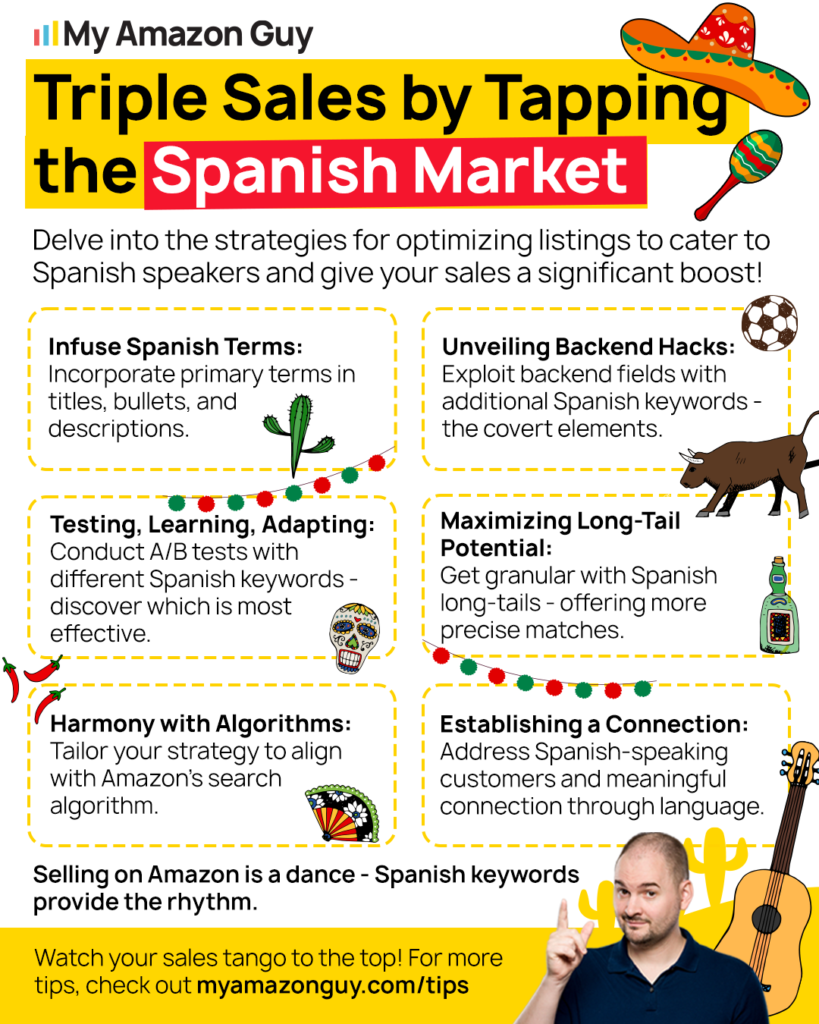
Don'ts in Using Backend Keywords on Amazon
1. Ignore Amazon’s Guidelines
Amazon prohibits certain keywords, including competitor brand names, offensive language, and misleading terms. Violating these rules can result in de-indexing or account suspension.
2. Keyword Stuffing
Repeating the same word or phrase doesn’t improve ranking and wastes valuable space. Focus on diverse, high-quality keywords instead.
3. Add Irrelevant or Misleading Keywords
Using unrelated terms to attract clicks can lead to poor conversions and hurt your ranking. Only include relevant keywords that accurately describe your product.
4. Use Promotional or Subjective Phrases
Terms like “best”, “#1 seller”, and “top-rated” are not allowed in backend keywords. Amazon wants factual, search-based terms, not marketing claims.
5. Duplicate Keywords from Your Listing
Backend keywords should complement your product title and description, not repeat them. Amazon already indexes visible content, so use the backend for additional search terms.
How to Add Backend Keywords on Amazon Product Listings
Once you’ve chosen the best backend keywords for your product, the next step is adding them to your Amazon listing. Follow this step-by-step guide to update your backend keywords in Amazon Seller Central easily.
Step 1: Log in to Amazon Seller Central
- Go to Amazon Seller Central and sign in with your credentials.
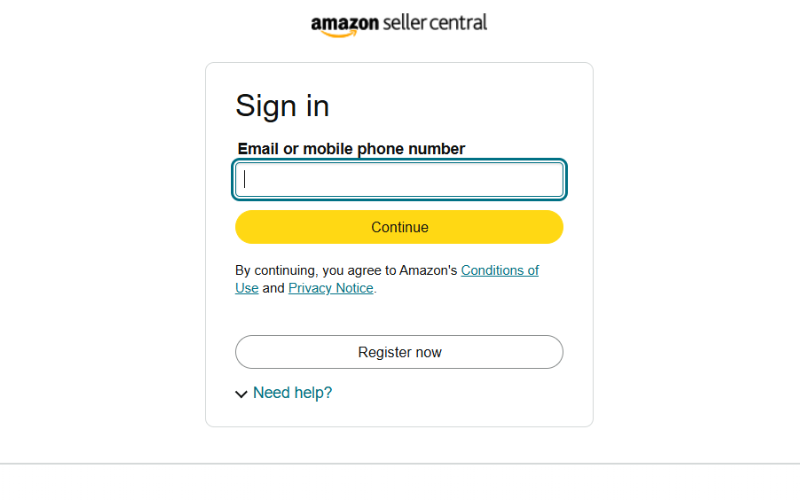
Step 2: Go to the Manage All Inventory Section
- On your Seller Central dashboard, go to Inventory > Manage All Inventory to access your product listings.
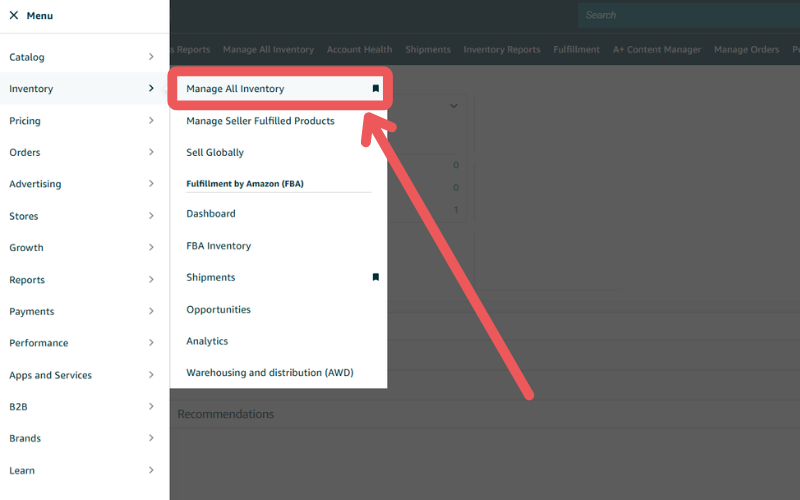
Step 3: Select the Product to Edit
- Find the product you want to optimize.
- Click the Edit button next to the listing. This will take you to the product detail page.
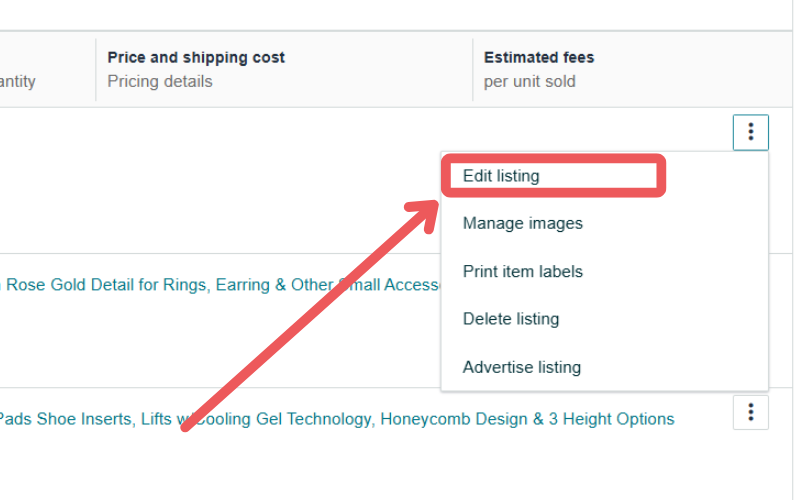
Step 4: Go to the Product Details Tab
- In the submenu, go to the Product Details tab.
- Scroll down to the Generic Keyword field. This is where you’ll enter your backend keywords.
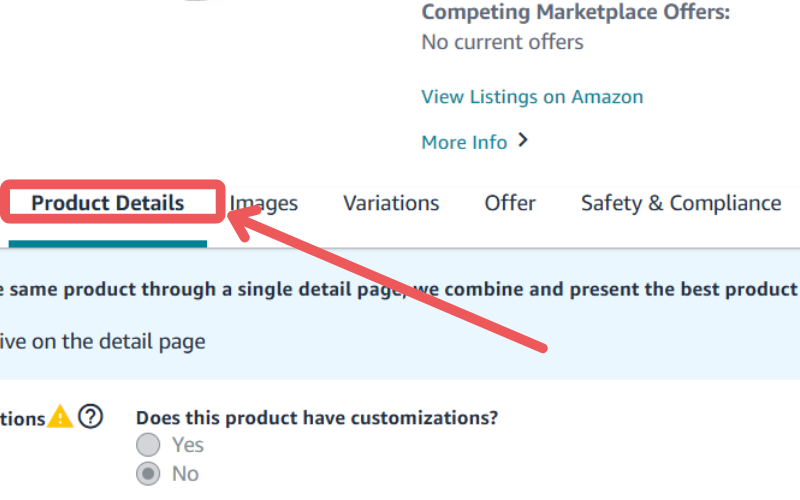
Step 5: Add Your Backend Keywords
- Enter your 250 bytes of backend keywords in the Generic Keyword field.
- Input relevant terms that describe your product, separating them with spaces.
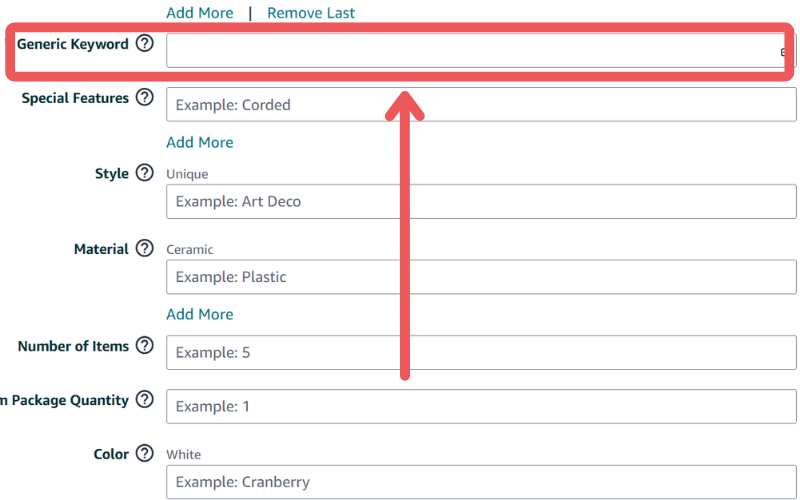
Step 6: Save Your Changes
- Click Save and Finish to update your product listing.
- Amazon will index your backend keywords, which can help improve your product’s search rankings.
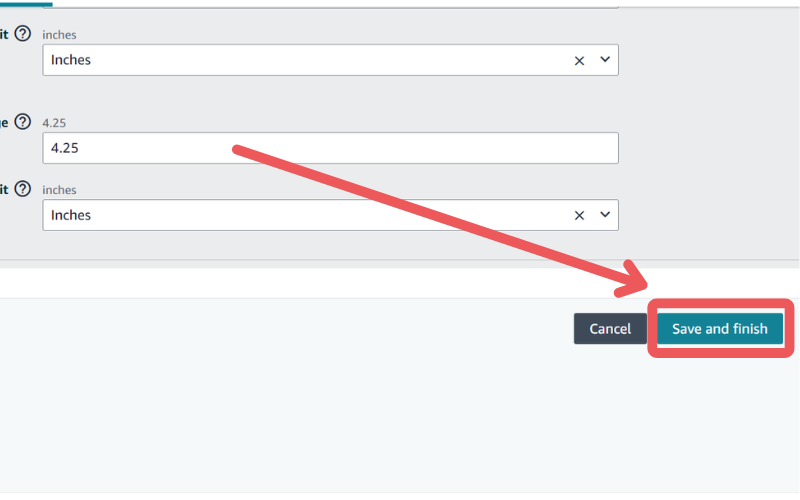
Checking If Your Backend Keywords Are Indexed
Ensuring your backend keywords are indexed is crucial for your product’s visibility on Amazon. If a keyword isn’t indexed this means your listing will not show up in the search results for that term.
Here’s how you can quickly check if Amazon recognizes your keywords.
Using Amazon’s Search Bar
- Find Your Product’s ASIN
- The ASIN is a 10-character unique identifier for your product.
- You can locate it in the product URL or under the Product Information section on the listing page.
- Check Indexing with an ASIN Search
- In the Amazon search bar, enter: ASIN + keyword
- Example: B08XYZ1234 dog training pads
- If your product appears in the search results, Amazon has indexed that keyword. If not, it isn’t indexed.
- In the Amazon search bar, enter: ASIN + keyword
Using Keyword Indexing Tools
Checking multiple keywords manually can be time-consuming. Keyword indexing tools offer a faster solution:
- Helium 10 Index Checker
Checks whether Amazon recognizes specific keywords for your product. - ZonGuru
Provide free and paid tools to verify keyword indexing. - Google Site Search
Use the ASIN + keyword in Google’s search bar to see if Amazon has indexed the term.
FAQs About Amazon Backend Keywords
How Many Backend Keywords Can I Use?
Amazon limits backend search terms to 250 bytes (including spaces). Stay within this limit to ensure all keywords are indexed. Use short, relevant phrases instead of single words when possible to maximize coverage.
Does the Order of Backend Keywords Matter?
No, the order of backend keywords does not impact search ranking. Amazon indexes them collectively, meaning it recognizes all the words in any order. However, avoid filler words and focus on highly relevant search terms to maximize effectiveness.
Can I Repeat Keywords from My Listing in Backend Search Terms?
No, avoid duplication. Amazon already indexes keywords in your title, bullet points, and description, so repeating them in the backend is a wasted opportunity. Instead, use variations, synonyms, or additional long-tail keywords to cover more search queries.
Should I Add as Many Backend Keywords as Possible?
No, quality matters more than quantity. Backend keywords should be relevant, high-ranking, and not duplicated from visible listing content. Amazon allows 250 bytes for backend search terms, so use this space efficiently by avoiding unnecessary words like punctuation, repeated words, or competitor brand names.
Does Amazon Penalize Keyword Stuffing in Backend Search Terms?
Yes, but in a different way than visible keyword stuffing. If you exceed the 250-byte limit, Amazon may ignore all backend search terms for that listing. Avoid overuse of irrelevant keywords, competitor names, and special characters to ensure full indexing.
Can I Use Competitor Brand Names in Backend Keywords?
No, using competitor brand names in backend search terms violates Amazon’s policies. Adding competitor brand names to your product listings can lead to listing suppression or suspension. Stick to generic, descriptive, and relevant keywords that accurately represent your product.
Maximize Visibility with Backend Keywords
Making sure your products are visible to potential customers is essential because if shoppers can’t find your listing, they won’t be able to buy your product no matter how great it is. Backend keywords play a crucial role in improving visibility by helping Amazon’s algorithm index your product for more search terms.
Optimizing your backend keywords ensures you capture relevant traffic and stay ahead of the competition. So, improve your listings by following the Amazon backend keyword best practices we mentioned in this article to increase your chances of ranking higher, attracting more customers, and driving sales.
Need help optimizing your product listings? Our Amazon agency has a team of experts ready to assist you—contact us today!





